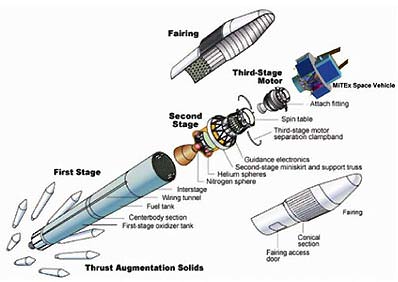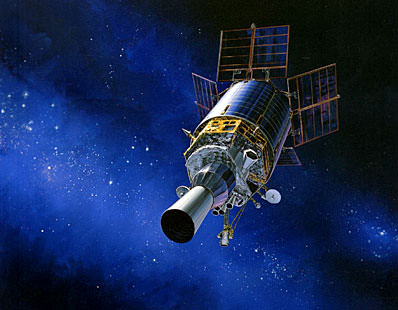[/caption]
Two small, covert inspection satellites capable of maneuvering around in geosynchronous orbit are being used by the U.S. Defense Department to inspect a $400 million missile warning satellite that failed in 2008. This is the first time this type of operation has been done, demonstrating a new ability by the U.S. military. “There is not much we do in space any more that is really new, but this is really new,” said John Pike, who heads the military think tank GlobalSecurity.Org, in an article by Craig Covault in Spaceflightnow.com. Pike went on to say that although this operation is being used to obtain data on a failed U.S. spacecraft, such inspections of especially potential enemy spacecraft, is something the Pentagon has wanted to do since the start of the space age. And what implications would this type of spacecraft have for NASA’s ability to monitor and repair satellites and orbiting spacecraft in the future?
The U.S. Air Force/Northrop Grumman Defense Support Program DSP 23 missile warning satellite was launched successfully in 2007, but failed shortly after in 2008. It was the first launch of the Delta 4-Heavy booster, which was recently used again to launch a military satellite on January 17, 2009.
The satellites are about 40,230 km (25,000 miles) above the Earth. The Orbital Sciences and Lockheed Martin “Mitex” inspection spacecraft are part of a classified Defense Advanced Research Projects Agency (DARPA) technology development program. When they were launched in 2006, the project involved maneuvering around and inspecting each other in geosynchronous orbit. But no data is available to indicate whether the two spacecraft may have secretly paid visits to one or more non-U.S. spacecraft in the geosynchronous: everything about these spacecraft is classified.

The small Mitex spacecraft are unusually small — only about 500 pounds each. Most all geosynchronous satellites are much larger. Officials from Union of Concerned Scientist’s Global Security Program. Said that the Chinese will complain about the operations to the international community in Geneva, Switzerland, as they are concerned about the implications of these satellites’ capabilities, but also about how the U.S. is always complaining about the need for transparency in Chinese space operations, but now the U.S. is conducting secret operations.
While the military aspects of the Mitex spacecraft are unique, it also provides fuel for thought about what these type of spacecraft could mean for NASA and commercial satellite companies for surveillance and possible repair of satellites and orbiting spacecraft.
For more information about the military implications of this surveillance spacecraft see the article on Spaceflightnow.com.


Could these possibly be used to regularly inspect manned spacecraft such as the ISS, space shuttle or Orion? Or is it too risky to have an unmanned spacecraft maneuvering so closely to a manned spacecraft?
Human: The technology is vastly different here as these defense satellites are over 100 times further from earth than the ISS. 40,000 km, vs 350 km.
Hmmmmm, ProjectBlue Beam???
😮
“The satellites are about 40,230 km (25,000 miles) above the Earth”
This formulation is either misleading or incorrect.
Does ‘above the Earth’ mean ‘above the Earth’s surface’ (orbit height) or ‘above the Earth’s center’ (orbit radius)?
The geostationary orbit has a radius of 42,164 km (26,199 mi); which gives a height of 35,786 km (22,241 mi) above mean sea level (See ‘Geosynchronous orbit’ on Wikipedia).
None of these figures fit with the given information, by more than 1000 miles.
So do we have to understand that the Mitex spacecraft orbit some distance either above or below geostationary orbit?
This would certainly make sense, as such an orbit would naturally let them drift past geostationary satellites; but 1000 miles away or more is quite far for close-up inspections, let alone ‘monitoring and repair’, and moving closer would require a big lot of fuel.
The original Spaceflight Now article refers to ‘the geosynchronous arc … at about 22,300 miles altitude’.
It also states: “It is not known how close this initial Mitex got to DSP 23, but their signatures essentially merged starting about Dec. 23. This could possibly mean the initial Mitex moved in close to DSP 23 to image it or perform other diagnostic work …” Very close indeed!
So it looks like we do talk about (almost) geostationary orbits (and not geosynchronous as incorrectly stated in both articles).
Generally speaking, it is misleading to state a figure with 2 significant digits (25,000), along with a 4 significant digit conversion (40,230), as it might be falsely understood as meaning exactly 25,000 miles +/- 5 mi.
Better formulations would have been 36,000 km (22,000 mi) with 2 significant digits, or 35,800 km (22,200 mi) with 3.
~~~~~~~~~~~
Shepard Says:
January 23rd, 2009 at 1:07 am
Hmmmmm, ProjectBlue Beam???
~~~~~~~~~~~
Not knowing what that was, I did a search for it and upon skimming thru one of the articles I found, it sounds like religious psycho babble. Just like FEMA Camps, FEMA Caskets, etc, etc.
Could some clever person tell me what modifications, extra fuel, etc. would be required to let a space shuttle truck up there and be useful?
Being that this project is classified, it doesn’t suprise me that they are giving out inaccurate data.
“Could some clever person tell me what modifications, extra fuel, etc. would be required to let a space shuttle truck up there and be useful?”
Answer: None. Even with maximum OMS propellant, and zero payload in the cargo bay, a Space Shuttle orbiter can’t get higher than about 600 miles above the Earth.
And that’s okay. The Shuttle’s design was trying to be too many things to too many people already. Going beyond LEO is not what it was meant for. Launching stuff that *can* go farther (including, if necessary, assembly of such systems in LEO) *was* its purpose.
What you want is some kind of re-usable, orbit-to-orbit ‘space tug’ for such servicing.
Howard, Frank:
Just for the fun, I tried to put a few figures on the question.
Speed on LEO (low earth orbit) is about 8 km/s; on GEO it is 3 km/s.
From one to the other, you have to go through Geostationary Transfer Orbit (GTO); where speed is 10 km/s at perigee and 1.6 at apogee.
This means you have to accelerate your spacecraft by 2 km/s (from LEO to GTO perigee), then again by 1.4 km/s (from GTO apogee to GEO).
And if you really insist on going there by shuttle, then you might also wish to come back: you’d have to give those same 2 kicks again.
Let’s suppose you convert a Space shuttle’s entire payload to extra fuel, and pipe that cost-free (meaning mass-free) to the main engines.
Playing around with ‘Tsiolkovsky’s rocket equation’ (see Wikipedia), considering the Orbiter’s total mass to be around 100,000 kg, with main engines Effective Exhaust Velocity at 4,400 m/s (also see Wikipedia, you can get this information from various pages about orbits and spacecraft), then just the first of these 4 burns (to reach GTO) would require more than 50,000 kg of fuel. Problem: the max payload is 25,000 kg. You couldn’t even make it to GTO!
The actual max mass the Shuttle can send to GTO is 3,800 kg; this includes the additional fuel and engine which provide the GTO to GEO burn. And of course does NOT include the Shuttle orbiter!
A more effective launcher is the Delta-4 Heavy, which sends up to 12,800 kg to GTO (or 6,300 kg to GEO).
Of course the Space shuttle as a system is much more powerful than other launchers, but most of that power is needed to orbit the Orbiter itself!
Inscribete y recibiras noticias periódicas de esta revista